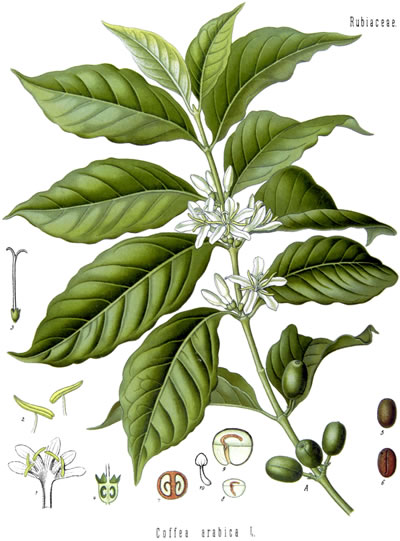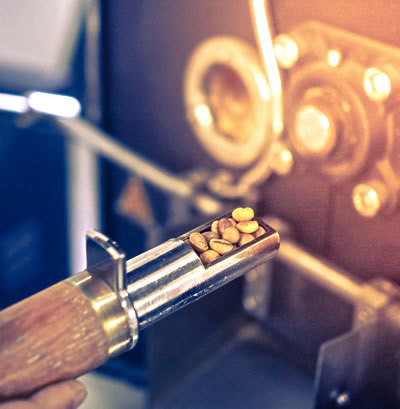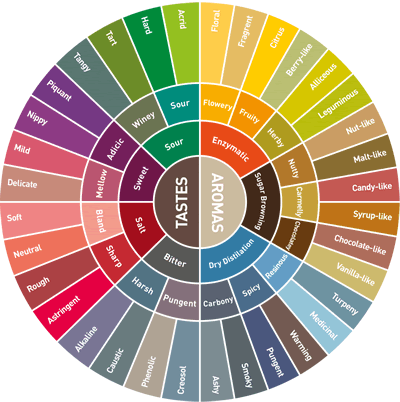Origins
Coffee was first discovered in Northern Africa in the area of Ethiopia. Popular legend says a goat herder named Kaldi observed his goats acting unusually energetic after eating the cherries of a shrub and tried them himself. News of the renewed energy the plant's cherries spread quickly. In the 1700's, coffee made its way to the Americas by a French military captain who brought a single plant across the Atlantic to the Caribbean.
Biology
Coffee is the seed of the cherry fruit from the evergreen coffee tree. Coffee trees can grow to 20 feet but are pruned to 8-10 feet to simplify harvesting. Coffee cherries ripen at different times so most coffee is picked by hand.
There are two species of coffee trees (and beans): Coffea arabica and coffea robusta. Arabica coffees grow best at altitudes over 3000 feet and produce superior quality coffees in terms of flavor and aroma. Arabica coffee's caffeine is half that of robusta coffees, which are grown at lower elevations, are easier to grow, more disease resistant and produce higher yields. Robusta coffees are often added to espresso blends for their crema characteristics.
Roasting
Roasting of coffee is done either by drum roasting or hot air roasting. Sky Mountain Coffee roasts its coffee in a drum roaster. Green coffee is roasted for between 12-18 minutes in temperatures ranging between 400-460º F. The process caramelizes sugars and carbohydrates in the bean to produce the browned color and aromas. Roasting will cause the beans to plump 50% in size while losing around 16% water weight. Terms such as city, full city, Viennese, French, and Italian are used (with some latitude) to describe degrees or levels of roast.
Freshness
Proper storage of coffee is critical to maintaining flavor. A cool, dry, air-tight container is the best way to store whole bean coffee as air and moisture cause coffee to stale fairly quickly. It is preferable to grind coffee prior to brewing as ground coffee increases the surface area and therefore accelerates the staling process. Freezing coffee does not stop the staling process. It is best to buy your coffee like you do milk, buy what you need for the next 7-10 days.
Brewing
There are a variety of coffee brewing devices, among them pour-overs, French Press, vacuum pots and filter drip machines. A great cup of coffee requires the proper amount of fresh coffee, 2 tablespoons per 6 ounce cup, mingle with fresh 190-205ºF water for between 4-9 minutes, depending on your coffeemaker. This creates the perfect environment for extracting the rich flavor and aromas while leaving the bitter, woody components behind.
Tasting vs. Cupping
Coffee tasting is a method of experiencing several coffees side-by-side for the purpose of education. Coffee cupping is a traditional method of evaluating coffee which involves visual examination of the green and roasted coffee followed by a ritualized process of brewing ground coffee directly in the cup. This unfiltered brew is then used to evaluate the coffee’s aroma, body and flavor.
Four tasting parameters:
- Acidity is the sensation of dryness on your tongue and provides the sharp, bright, vibrant quality that is desirable in a quality coffee. Coffees lacking acidity are considered flat.
- Aroma engages our sense of smell to extend the basic tastes of sweet, sour, salty and bitter with the complexities of “floral, winy, vanilla, herbal, etc.”
- Body describes the feeling of viscosity, thickness or richness in your mouth; consider the difference between whole milk and water.
- Flavor is the overall perception of acidity, aroma and body in your mouth. Richness, complexity and balance would be examples of general flavor characteristics. Examples of specific desirable flavor characteristics: Bright, dry, sharp, snappy, caramelly, chocolaty, delicate, earthy, fragrant, fruity, mellow, nutty, spicy, sweet, wildness and winy. Some undesirable flavors: bitter, carbony, dirty, musty, sour, turpeny, watery, etc.
